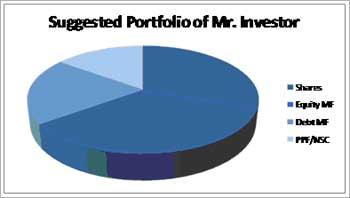 Risk has always been the centre point of most theories in investments and financial markets, but is seldom talked about by the financial world. Only if one has the motivation to dig into details of the terms and conditions or prospectus of a security, she will find information about the risk pertaining to this particular security.
Risk has always been the centre point of most theories in investments and financial markets, but is seldom talked about by the financial world. Only if one has the motivation to dig into details of the terms and conditions or prospectus of a security, she will find information about the risk pertaining to this particular security.
Though the real world does not talk about it much, it is imperative on part of an investor to understand the importance of this concept. Risk can be related to market or any particular investment or an investor. In this article, we shall discuss about risk profile of an investor.
For starters, risk profile can be put as how much variation in returns from investment can be easily accommodated by an investor. Is it that a 10 per cent in a year will make the financial plan of investor weak or is it that even a 50 per cent return in a year is adjustable in the portfolio. This assessment helps us in a lot of ways.
Risk profile helps us in deciding which asset classes to invest in. An asset class can be a group of securities which have common characteristics risk, maturity, cost of trading, etc.
Say, for example, if an investor has a considerable risk appetite, she can invest in derivatives which are taken as the most risky investments. And based on the knowledge of her risk appetite, she can choose the particular investment to be made.
Continuing with our example, the investor can put money into futures, puts or calls or other strategies. Also, geography of investments can be assessed from the risk profile. Market experts say that developed economies are much less volatile, or less risky than developing economies. An individual with a low risk appetite may want to invest greater part of portfolio in developed economies like UK, US, Japan, etc.
After realising the importance of understanding the risk profile, the next task is to identify it. There are two truths about risk profile that need mention here - identification of risk profile, which is not an easy task; and risk profile is specific to an investor.
But there are many tools available today which help us in this process. Many investment websites, mutual fund companies and insurance companies provide model risk profile of investors.
Starting with assessment of the factors that affect an investor's risk profile, let us first explore current income of the investor. If the current income can take care of the investor's compulsory requirements then the investor can opt for riskier investments.
Second factor can be investor's knowledge about financial markets and investment. For someone who finds a bull as an animal only, it would be a sensible decision to refrain from investment in complex products like derivatives. Age is another factor that governs the investment pattern for an investor. A young professional with minimal responsibilities and long investment duration can think of putting more money in riskier securities.
However, this might not be true for someone who has family responsibilities like dependent parents and children. Such an investor will look at safer investments. The duration of investing is said to be another important factor. A long investment horizon is preferred. That is why it is said that the sooner we start investing the better it is.
An illustration should make the points clearer. Say Mr Investor wants to know his risk profile. We can make a reasonable approximation of Mr Investor's risk profile based on our above discussion. Say Mr Investor has a cash salary income of Rs 12 lacs per annum or Rs 1 lac per month.
Mr Investor has a monthly household expenditure of Rs 20,000, housing loan instalment of Rs 25,000 and other average miscellaneous expenses of Rs 5,000. This leaves a clear income of Rs 50,000 at disposal for investment or other purposes. Based on this parameter, he can have riskier investments or more exposure of equity products.
Mr. Investor is a techie and has very little knowledge of investing and risks associated with investing. This is a limitation that makes Mr. Investor's risk profile conservative. He must, though, overtime gain knowledge on the subject to become capable of understanding and handling risky securities. The age group in which Mr. Investor falls is 35-40. This age group has responsibilities of children, their education, etc.
As a result, he will have to be prudent while selecting the asset classes. Also, he must make sure he has secured the money well before the requirements are planned. This will remove possibility of any sudden market fall majorly affecting his corpus. Even as the age group of 35-40 has responsibilities he has a long time for his retirement planning or higher education of children or their marriage. To meet these needs, Mr Investor might consider a longer investment horizon which means he can take more risk and put his money in growth investment products. Overall, Mr Investor can have a bit of aggressive portfolio. There is no ideal portfolio in the practical world but a suggested portfolio can be -

Taking a stock of such factors should yield a better understanding of investing and what to expect from it. Investing is may not be a very fruitful exercise without any goal (return). But measuring return without assessing risk could be misleading. So start this exercise today by calculating your net worth, diagnosing the above factors and taking sensible investment decisions.









